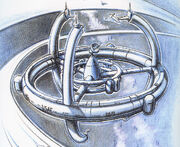m (+cat) |
m (cat) |
||
| Line 7: | Line 7: | ||
[[Douglas Pabst]], the editor of Incredible Tales, was troubled by the story, however. In particular he stressed that the story's main character, a space [[captain]], would not be believable to the magazine's readers because he was a black man. Because of this he did not believe the [[Stone (publisher)|Mr. Stone]], publisher of Incredible Tales, would allow the story to be published in the [[racism|racist]] climate of the time. Russell eventually agreed to alter the story so that the ending portrayed all of the events as nothing but the dream of a black child from the present. Pabst reluctantly decided to allow the story to proceed with this change but in the end he was overruled by the publisher who cancelled that month's issue of the magazine rather than let the story see print. ([[DS9]]: "[[Far Beyond the Stars]]") |
[[Douglas Pabst]], the editor of Incredible Tales, was troubled by the story, however. In particular he stressed that the story's main character, a space [[captain]], would not be believable to the magazine's readers because he was a black man. Because of this he did not believe the [[Stone (publisher)|Mr. Stone]], publisher of Incredible Tales, would allow the story to be published in the [[racism|racist]] climate of the time. Russell eventually agreed to alter the story so that the ending portrayed all of the events as nothing but the dream of a black child from the present. Pabst reluctantly decided to allow the story to proceed with this change but in the end he was overruled by the publisher who cancelled that month's issue of the magazine rather than let the story see print. ([[DS9]]: "[[Far Beyond the Stars]]") |
||
| − | [[Category: |
+ | [[Category:Earth arts and literature]] |
Revision as of 09:09, 20 October 2005

Concept art
Deep Space Nine was the title of a short-story/novella written by Benny Russell for Incredible Tales.
The story revolved around the crew of a space station in the far reaches of the galaxy and featured a wide array of alien species and future technology. Russell created the story based on visions and dreams he was having at the time, which were actually the life events of his counterpart Benjamin Sisko some 400 years in the future, and which finally began to take shape when the magazine's house illustrator, Roy Ritterhouse, presented him with a picture of a vaguely familiar station.
The story was greeted enthusiastically by the other members of the writing staff, including Herbert Rossoff who thought the setting fascinating and found the title "very intriguing".
Douglas Pabst, the editor of Incredible Tales, was troubled by the story, however. In particular he stressed that the story's main character, a space captain, would not be believable to the magazine's readers because he was a black man. Because of this he did not believe the Mr. Stone, publisher of Incredible Tales, would allow the story to be published in the racist climate of the time. Russell eventually agreed to alter the story so that the ending portrayed all of the events as nothing but the dream of a black child from the present. Pabst reluctantly decided to allow the story to proceed with this change but in the end he was overruled by the publisher who cancelled that month's issue of the magazine rather than let the story see print. (DS9: "Far Beyond the Stars")
